Matador Network's Blog, page 81
January 2, 2025
The 20 Biggest Concert Tours Worth Booking a Trip For in 2025

In 2024, the highlight of many people’s travels revolved around basing an entire trip around a concert. Call it gig tripping, concert tourism, touring for the tunes, or whatever you want — there’s no denying that music travel has taken off in recent years. And although Taylor Swift’s destination-worthy “Eras Tour” is over, there is much to look forward to in 2025.
From pop sensations to classic groups that have been making hits for decades, these are the biggest concert tours worth booking a trip for in North America, Europe, and Oceania.
Zayn Malik: Stairway to the Sky TourWhen: November 2024 – February 2025
Where: North America
Zayn Malik’s “Stairway to the Sky Tour,” supporting his “Room Under the Stairs” album, is ongoing with rescheduled US dates in January and February 2025 in cities like Washington D.C., New York, Los Angeles, Las Vegas, and San Francisco.
Learn MoreSabrina Carpenter: Short n’ Sweet TourWhen: September 2024 – March 2025
Where: North America and Europe
Sabrina Carpenter’s “Short n’ Sweet Tour,” her first arena headlining tour, supports her sixth album of the same name and spans North America and Europe with 53 shows. The tour features supporting acts like Amaarae, Rachel Chinouriri, Griff, and Declan McKenna.
Learn MoreGracie Abrams: The Secret of Us TourWhen: September 2024 – May 2025
Where: North America, Europe, Australia and New Zealand
Gracie Abrams’ “The Secret of Us Tour,” supporting her second album of the same name, is a large-scale tour spanning North America, Europe, and Oceania from September 2024 to August 2025. Due to high demand, additional shows, including “Deluxe Tour” dates in larger venues like Madison Square Garden and Red Rocks Amphitheatre, have been added. The tour features special guest Role Model for the “Deluxe” North American leg, offering fans a chance to see Abrams perform her latest music in her biggest venues to date.
Learn MoreBillie Eilish: Hit Me Hard and Soft: The TourWhen: September 2024 – July 2025
Where: Australia, Europe, and the UK/Ireland
Billie Eilish’s “Hit Me Hard and Soft: The Tour,” supporting her third studio album, spans from late 2024 into 2025, encompassing North America, Australia, Europe, and the UK/Ireland. Known for its immersive visuals and Eilish’s captivating stage presence, the tour showcases both new material and fan favorites.
Learn MoreGreen Day: The Saviors TourWhen: January – June 2025
Where: Europe, Australia, Asia and Africa
Green Day’s “The Saviors Tour,” a massive global stadium tour running from May 2024 to September 2025, celebrates the 30th anniversary of “Dookie” and the 20th anniversary of “American Idiot” alongside their new album “Saviors.” Featuring rotating supporting acts like The Smashing Pumpkins, Rancid, The Linda Lindas, and Nothing But Thieves depending on the leg, the tour sees Green Day performing both iconic albums in their entirety, plus new material.
Learn MoreBilly Joel: 2025 TourWhen: January – June 2025
Where: United States
Billy Joel’s 2025 tour includes a mix of solo headlining shows and co-headlining stadium concerts with fellow rock legends like Stevie Nicks and Sting. With dates across North America and the UK, the “Piano Man” will be performing his classic hits in venues ranging from arenas to stadiums, offering fans multiple opportunities to experience his iconic music live.
Learn MoreJustin Timberlake: The Forget Tomorrow World TourWhen: January – July 2025
Where: North America, South America and Europe
Justin Timberlake’s “The Forget Tomorrow World Tour,” his first in five years, supports his sixth studio album, “Everything I Thought It Was.” This massive tour, which began in April 2024 and extends into July 2025, spans North America, Europe, and South America. Featuring a dynamic stage production and a mix of new music and classic hits, the tour has seen high demand and numerous added shows, solidifying its status as one of Timberlake’s biggest tours to date.
Learn MoreCyndi Lauper: Girls Just Wanna Have Fun Farewell TourWhen: February – April 2025
Where: Europe, Australia, and Asia
Cyndi Lauper’s “Girls Just Wanna Have Fun Farewell Tour,” launching in 2024 and extending into 2025, marks her final major tour and celebrates her illustrious career. Featuring special guests on select dates, the tour will see Lauper performing her iconic hits and fan favorites across North America.
Learn MoreTyler, the Creator: Chromakopia: The World TourWhen: February – September 2025
Where: North America, Europe, Australia, and New Zealand
Tyler, the Creator’s “Chromakopia: The World Tour,” supporting his recent works, is a visually striking and creatively ambitious tour spanning North America, Europe, Australia, and New Zealand. Known for his unique stage design, energetic performances, and genre-bending music, Tyler delivers a dynamic setlist blending his diverse discography, from early hits to newer material, accompanied by elaborate sets and immersive visuals, creating a captivating and often theatrical live experience.
Learn MoreUsher: Past Present Future TourWhen: March – May 2025
Where: Europe
Usher’s “Past Present Future Tour,” launched in 2024 and continuing into 2025, celebrates his 30-year career and supports his ninth studio album, “Coming Home.” This large-scale tour spans North America and Europe, showcasing a dynamic setlist that journeys through Usher’s extensive catalog of hits, from his early beginnings to his latest releases. The tour has been met with significant demand, leading to numerous added shows.
Learn MoreJelly Roll: The Beautifully Broken: Great Northern TourWhen: March 2025
Where: Canada
Jelly Roll’s “The Beautifully Broken: Great Northern Tour” marks his first international headlining tour, taking him across Canada in March 2025. This 12-city tour, supporting his album “Beautifully Broken,” kicks off in Victoria, British Columbia, and includes stops in major cities like Vancouver, Edmonton, and Toronto before concluding in Quebec City. Fans can expect to hear his raw and emotional hits, with special guests Josh Ross, Savannah Dexter, and Brabo Gator joining him on all dates. He will join Post Malone on his Big Ass Stadium Tour in the summer.
Learn MoreDua Lipa: Radical Optimism TourWhen: March – October 2025
Where: North America, Europe, Australia and New Zealand
Dua Lipa’s “Radical Optimism Tour,” supporting her third studio album of the same name, is a global tour spanning Europe, Oceania, and North America from late 2024 into 2025. Following her acclaimed Glastonbury performance, the tour showcases her latest music alongside her extensive catalog of hits, with high demand resulting in added shows, including multiple nights at London’s Wembley Stadium.
Learn MoreOlivia Rodrigo: Guts World TourWhen: March – July 2025
Where: Latin America and Europe
Olivia Rodrigo’s “Guts World Tour,” her first arena tour, supports her second album, “Guts,” and has been a massive global undertaking spanning North America, Europe, Asia, Oceania, and South America from early 2024 into mid-2025. With a setlist featuring both new tracks and hits from her debut album “Sour,” the tour has seen high demand and features rotating opening acts like The Breeders, Chappell Roan, PinkPantheress, and Remi Wolf.
Learn MoreKendrick Lamar and SZA: Grand National TourWhen: April – June 2025
Where: North America
Kendrick Lamar and SZA’s “Grand National Tour” is a highly anticipated co-headlining stadium tour across North America in Spring 2025. This marks the first all-stadium tour for both artists, kicking off in April and concluding in June with 23 shows across the United States and Canada. Fans can expect a mix of Kendrick’s dynamic lyricism and SZA’s captivating vocals, potentially including their collaborative hits like “All the Stars” and “Doves in the Wind.”
Learn MorePost Malone: Big Ass Stadium TourWhen: April – July 2025
Where: North America
Post Malone’s “Big Ass Stadium Tour,” launching in April 2025, is his largest headlining tour to date, taking him to 25 stadiums across North America. Supporting his sixth studio album, “F-1 Trillion,” the tour features a mix of his biggest hits, fan favorites, and new music, with special guests Jelly Roll joining him on all dates and Sierra Ferrell supporting on select dates.
Learn MoreEd Sheeran: +–=÷× (Mathematics) TourWhen: April 2022 – September 2025
Where: Europe and Middle East
Ed Sheeran’s +–=÷× (Mathematics) Tour is a massive global stadium tour that began in April 2022 and continues into September 2025. Supporting his albums “=” and “-“, the tour is known for its impressive in-the-round stage production, featuring a rotating central stage and extensive use of screens and pyrotechnics. Sheeran performs a career-spanning setlist, often utilizing loop pedals to create a full band sound despite primarily being a solo performer, offering fans a dynamic and immersive concert experience.
Learn MoreBruce Springsteen: 2025 World TourWhen: May – July 2025
Where: Europe
Bruce Springsteen and The E Street Band’s 2023-2025 world tour, their first together since 2017, continues into 2025 with rescheduled and newly added dates, primarily in Europe. After postponements in 2023 and 2024 due to health issues, the tour is set to conclude in July 2025 in Milan, featuring a mix of classic hits and material from recent albums like “Letter to You” and “Only the Strong Survive.”
Learn MoreKeith Urban: High and Alive World TourWhen: May – October 2025
Where: U.S. and Australia
Keith Urban’s “High and Alive World Tour,” his first in three years, kicks off in May 2025 in North America, with potential international dates to follow. Supporting his 2024 album “High,” the tour features a mix of new music and fan favorites, with Chase Matthew, Alana Springsteen, and Karley Scott Collins joining as support acts.
Learn MoreKaty Perry: The Lifetimes TourWhen: Starting in June 2025
Where: North America, Europe, and Australia
Katy Perry’s “The Lifetimes Tour,” her first tour in seven years, supports her upcoming seventh studio album, “143.” Kicking off in April 2025 in Mexico, the tour will take her across the globe with dates in North America, Europe, and Australia, concluding in November 2025 in Paris. This tour promises to be a career-spanning celebration of her music.
Learn MoreShania Twain: Summer 2025When: July – August 2025
Where: North America
Shania Twain’s Summer 2025 tour dates are a limited run of shows across North America, marking the final opportunity for fans to see this iteration of her live show. These dates follow two years of successful performances, including her “Queen of Me” tour and her Las Vegas residency. The summer 2025 shows begin in July and conclude in early August, hitting cities like Buffalo, Saratoga Springs, Bangor, Hershey, Jacksonville, and Hollywood, Florida. 
In Cancún, 3 Sandos Resorts Bring Culture Into the All-Inclusive Stay

Cancún is an undeniably popular tourist destination. In 2022, the region hosted nearly 10 million visitors. With seemingly endless beaches and clear waters, it’s not surprising to see so many travelers making their way to this area.
Hotel brands from luxury Cancún accommodations to budget-friendly properties have taken note. There’s surely no shortage of places to stay in Cancún, whether you’re looking for all-inclusive beach stays or an oasis of peace in the heart of the action. The hardest part of your trip planning may very well be picking the place to stay that’s perfect for what you want.
When it comes to stays that take care of your every need, Sandos Resorts focuses on showing how all-inclusives can also match the character of their locations. According to Xavier Ulloa, the Corporate Marketing Director at Sandos Hotels & Resorts, that’s what makes it special.
“While all of our properties are united under our common brand, they each offer completely different guest experiences and their own unique personality,” Ulloa says, adding, “Whether you’re swimming in a crystal clear cenote at Sandos Caracol Eco Resort, kayaking on the turquoise waters of Sandos Playacar’s beach, or listening to incredible live poolside music at Sandos Cancún, Sandos is dedicated to providing every guest with an unforgettable vacation unlike any other offered in the destination, all within our all-inclusive price tag.”
Of the 10 Sandos resorts in Mexico and Spain, three are in Cancún. I stopped by all three in one trip to find out which is best depending on the type of traveler and found plusses and minuses to each depending on the goal of the trip.
Sandos Caracol Eco Resort: A green resort in every way
Photo: Sandos Resorts
Cancún is best known for its beaches. About an hour’s drive south, Sandos Caracol is known for its jungle-like atmosphere, Maya ruins, and events around holidays like Día de los Muertos. While the resort does have a beautiful beach, its unique appeal lies in its wild-feeling grounds. That, along with the colorful Día de los Muertos decorations on display during my visit, was enough to make me feel giddy upon arrival.
My giddiness only grew as I explored the grounds, wandering through forested trails, searching for wildlife, and finding cenotes and ruins along the way. The only drawback to spending all of my time in the jungle was the occasional mosquitoes.

Photo: Sandos Resorts
In keeping with the property’s natural ambiance, Sandos Caracol prioritizes an eco-conscious approach to hospitality through solar energy, water conservation, and comprehensive recycling programs — all while providing comfort, convenience, and relaxation. Rooms come equipped with energy-efficient lighting and water-saving systems to reduce the resort’s carbon footprint (without sacrificing classic amenities like flat-screen TVs and minibars).

Photo: Sandos Resorts
My room had a queen-size mattress, a bunk bed for kids, and a private terrace. The rooms (941 in total) are divided into three sections: the jungle-view Family Section with superior room, suite, or penthouse options for four to five people; the adults-only, jungle-view Select Club with superior room, deluxe room, or penthouse options for two adults; and the Pool View Section with superior room, penthouse, or one-bedroom suite options for three adults or families of four.
Beyond the rooms, there’s always something to do at Sandos Caracol, from beachgoing and nature walks to pool and waterpark time. There’s also a spa with a variety of holistic treatments, including classic massages with herbs and oils. This is also where the fitness center is located, complete with a handful of machines, cardio equipment, and a rack of weights.

Photo: Sandos Resorts
As someone who loves both active and passive vacations, Sandos Caracol was ideal for me. When I was feeling energetic, I wandered through the flora and fauna. When I was ready for a nap, I headed for the closest beach hammock. And when I needed to pacify my thirst for adventure, I took a dip in the cenote near check-in, which is available for snorkeling for a few hours each day.
But the biggest highlight of my trip was the immersive experiences available to guests for free during the resort’s two-day Día de los Muertos festival.

Photo: Sandos Resorts
Of course, those who visit Sandos Caracol outside of Día de los Muertos in November still have access to plenty of events and experiences. You can see Maya ceremonies where you’ll learn about the region’s traditions and history. Dance and music performances are also common. Elsewhere, eco-conscious explorers can join one of the resort’s free tours where Sandos guides walk you through the local plants and animals and some of the property’s unique features.
All of that activity is bound to make you hungry. No problem: Sandos Caracol has seven restaurants, including a Mexican restaurant, a Brazilian steakhouse, and a Caribbean fusion restaurant. Many of the ingredients you’ll encounter at the restaurants are locally sourced, including produce like papaya, dragonfruit, avocados, and tomatoes. The breakfast buffet is another highlight, featuring international cuisine in a smart-casual environment. There are also a number of bars scattered throughout the resort that serve craft cocktails all day long.
Book NowSandos Playacar: An all-ages beach haven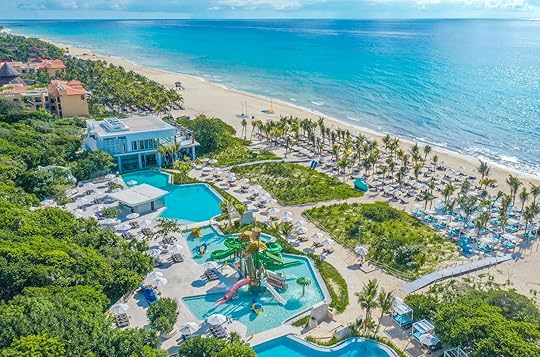
Photo: Sandos Resorts
If Sandos Caracol is the land of the jungle, Sandos Playacar is the dream beach resort. This property has a private beach on the Caribbean coastline in Playa del Carmen that’s kept pristine by bulldozers that move seaweed from the shore and employees who are always on the lookout for trash. The beach provides a relaxing atmosphere that’s slightly separated from the area of the resort where parties and festivities tend to take place.
Accommodations at Sandos Playacar are luxurious and spacious, with 819 rooms spread across the resort’s 60 acres. My visit brought me to an oceanview suite with two patios and one of the best views of the trip. I spent the majority of my time at the beach and the pool, but the rooms come with modern features like flat-screen TVs and minibars to keep you entertained when you’re not out enjoying the rest of the property. Some of the rooms have private jacuzzi tubs for a bit of added luxury.

Photo: Mary Beth Skylis
Sandos Playacar’s list of amenities is extensive. The property is home to multiple pools, including a swim-up bar that’s connected to an area with an in-pool volleyball net. There’s also an adults-only Select pool, which is extremely quiet and relaxing. Those looking for a restful experience might head to the spa while others might go to the pickleball courts for a feisty outdoor game.
While both Sandos Playacar and Sandos Caracol are kid-friendly, Sandos Caracol seems to place a heavier emphasis on family activities with its waterslide park and wide variety of sporting activities while Sandos Playacar provides many of the same amenities but seems to attract more adults. Nonetheless, there’s a Kid’s Club and a Teens Club, the latter of which has video games, pool tables, and other activities.
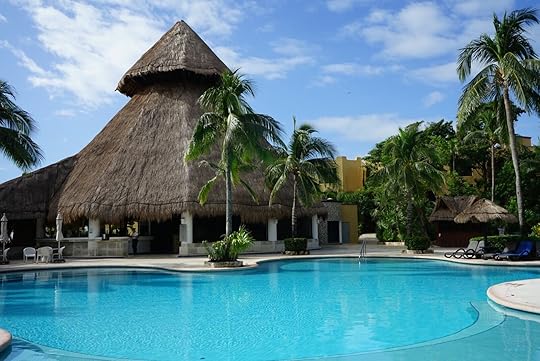
Photo: Mary Beth Skylis
Sandos Playacar also hosts regular entertainment on its main stage in the middle of the resort. During my visit, there was a historical show about the Maya that included elaborate costumes and dances. Rumor has it that the theater also hosts singers and bands showcasing both traditional and modern takes on music. While I didn’t experience one of the beachside events that are free for guests, the resort has been known to host themed parties late into the night.

Photo: Mary Beth Skylis
One area in which Sandos Playacar blew me away was its food selection, with a whopping 17 bars and restaurants ranging from Italian fare to traditional Mexican cuisine (although the greatest selection is regional). The on-site Mediterranean restaurant provides a nice opportunity to celebrate food with sweeping views of the beach. The breakfast buffet also comes with one of the widest selections of foods and treats that I’ve ever seen, with piles of bread, omelets, and fruit galore.
Book Now Sandos Cancún: A party on the hotel strip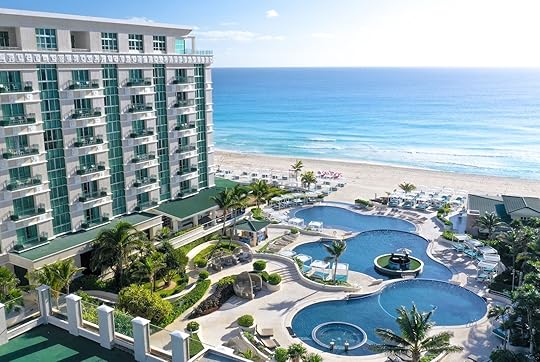
Photo: Sandos Resorts
Centrally located in Cancún’s hotel zone, Sandos Cancún creates a fun, upbeat atmosphere with regular DJ shows and a big focus on music. Converting to an adults-only resort in January 2025, it’s the place to go if you like to dance, hang by the pool, and revel in the sunshine.
Sandos Cancún is the smallest of the three resorts with 214 rooms. That helps to explain why the accommodations are modern and massive — many come with terraces where you can sip your morning coffee. Room types range from deluxe rooms with or without balconies to four-person suites. My room had a king-size bed, a bathtub, and a shower.
Like Sandos Playacar, this property features beautiful beaches, but it also has a three-tier pool. Compared to the other two Sandos properties, Sandos Cancún’s main focus seems to be on the pool and the beach but with more of a party vibe than Sandos Playacar since there’s generally a DJ or some other type of entertainment available.

Photo: Sandos Resorts
The bulk of Sandos Cancún’s entertainment is centered on music — predominantly dance-y contemporary music — but shows are also held in the northern part of the building. I caught a free aerial show that featured a number of balancing acts, including a man who stacked moving targets on a table before he stood on top of his wiggling tower. Another act demonstrated one woman’s strength while she balanced on her hands, using her flexibility to bring her toes to her head among other poses. The resort also hosts some themed evenings and beach parties.
The Spa del Mar offers a nice side quest with its relaxing facials, variety of massages, and hydrotherapy. The fitness center is located in the same building as the spa. Group fitness classes like yoga and stationary biking are also available.
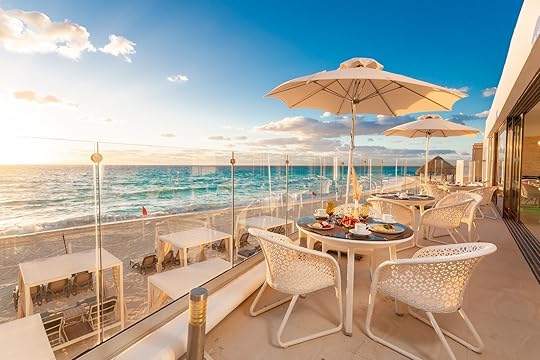
Photo: Sandos Resorts
Where dining is concerned, Sandos Cancún plays host to an Italian trattoria, a steakhouse, and an Asian fusion restaurant among its five restaurants (plus four bars). Each takes a sophisticated approach to the culinary experience, but the standout restaurant is French-leaning St. Trop due to its sweeping beach views and delicious bites like bouillabaisse, chicken cordon bleu, and caramelized apple tarte tatin for dessert. 
Canyon Bathing and Campus Vibes at One of Colorado’s Most Unique Hotels

Three factors play into making a boutique hotel, a good boutique hotel. The first is location. Is the hotel near what you plan to do while staying there? The second is dining and drinks. Third, but perhaps most important, is authenticity. Travelers booking boutique do so because they don’t want the cookie cutter experience of a major chain. Hotel Maverick, in Grand Junction, Colorado, excels at all three – effectively making it an anti-chain masterpiece in Colorado’s most underrated city.
We hope you love the Hotel Maverick! Just so you know, Matador may collect a small commission from the links on this page if you decide to book a stay. Listed prices are accurate as of the time of publication.
What stands out about Hotel Maverick
The coffee shop patio, pump track and campus behind. Photo courtesy Hotel Maverick
The most unique aspects of Hotel Maverick are its college campus location and student-staffing model. The 60-room propertyl is located on the Colorado Mesa University campus, walkable to the university’s sports and arts facilities. This makes it convenient for parents visiting their kids at school, as well as those attending games and events on campus (notably, the hotel is adjacent to the brand new Asteria Theater, which routinely hosts both university performances as well as national headlining acts including musicians, comedians, and lecturers.
The hotel has a unique student/staffing model that integrates with the university’s hospitality management program. The hotel actively recruits and employs CMU students in various roles, providing them with valuable real-world experience in the hospitality industry. Students, as such, gain practical skills in areas like front desk operations, housekeeping, food and beverage service, and guest relations – all while working towards their degree (and yes, the students are paid appropriate wages for their work). The experience provides students with valuable resume-building opportunities and prepares them for successful careers in the hospitality field.
Rooftop dining at The Devil’s Kitchen
Photo courtesy Hotel Maverick
Hotel Maverick also features fine dining on its rooftop. Devil’s Kitchen named after the iconic natural landmark about 10 minutes’ drive from the hotel, is pricey – plan to spend $30 or so on an entree, unless you opt for the cheaper Devil’s Burger. But, unlike at most post spots, your chance of leaving with leftovers is strong. Rarely are portion sizes so generous at a high-end restaurant. I had a plate of the seasonal ravioli, stuffed with green chili and cheese in this case, and it was fantastic. Paired with a shared plate of mussels to start, I was stuffed upon leaving the restaurant. Devil’s Kitchen is known, however, for its bison tamale, a mashup of ground bison, veggies, cotija, demi-glace, and sour cream. One of my co-diners ordered it, and we all dove in for photos as soon as it showed up (see below).
The restaurant’s cocktail program is among the best in western Colorado. Many cocktail recipes are courtesy of CMU Trustees. During my stay I became a fan of the mezcal-heavy Desert Bloom, and the bar also offers a variety of mocktails.
The hotel brought the Japanese concept of forest bathing to the desert
Our view while forest bathing. Photo: Tim Wenger
The term “Canyon bathing” sounds gritty and buff. In truth, however, it’s a mindful exercise built on the concept of Shinrin Yoku, or forest bathing, a practice that entails little more than spending time in the forest for no other reason than to spend time in the forest. The desert version, hosted by local naturalist Zebulon Miracle (real name, no peyote) was the coolest aspect of my stay at Hotel Maverick. We headed to a trailhead overlooking Colorado National Monument, hiked in a short distance, and sat overlooking the surrounding canyon country as Miracle guided our small group through a practice of awareness and appreciation.
The program, bookable through the Hotel Maverick’s front desk, is a unique initiative designed to encourage guests to immerse themselves in the distinct natural beauty of western Colorado. The experience was at once both meditative and activating. I felt calmed – by the surroundings as much as the guided practice.
Rooms at Hotel Maverick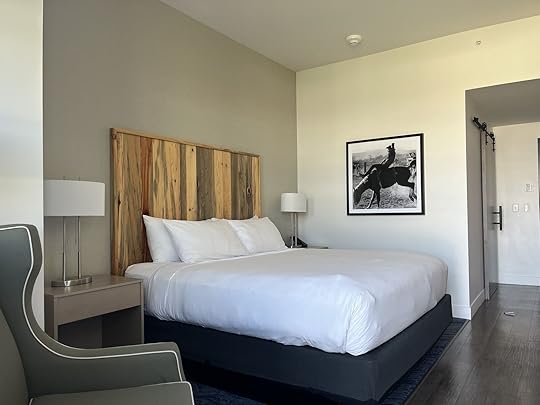
My room. Photo: Tim Wenger
My room at Hotel Maverick, a king room with a balcony overlooking the campus, was clean, comfortable, and efficient. When researching hotels online, I often find it tough to accurately discern the property’s level of cleanliness, comfort, and class. As a travel editor who spends 50 nights or more per year in hotels, I’ve developed a system to delineate whether a hotel is “nice” or “filthy.” It breaks down into the following aspects, and this is what I use to rate hotels:
According to photos on the hotel’s website or a third-party booking site, does the hotel accurately represent the vibe it purports to – i.e., is the decor hip, classic, retro, mid-mod? A hotel that markets itself as something other than the vibe blatantly viewable in photos is a no-go.Does the hotel use box springs? If the answer is yes, it’s likely a no-go. Box springs are among the most useless inventions of all time, accomplishing nothing other than taking up space while signaling a hotel’s inability to modernize and objectively assess the value delivered by its furnishing.Does the hotel promote its sustainability initiatives and, as appropriate, its ease of access to public transit, bicycle infrastructure, and the airport?How do the rest of the in-room furnishings look in photos? Are they crisp and maintained?Does the lobby have space to lounge and read, work remotely, or socialize?Hotel Maverick resoundingly ticks these boxes. Let’s get deeper into each. First, the hotel markets itself as what I’d describe as “mountain (or in this case, desert) chic” – hip and modern amenities and an accessible location, but with easy access to the outdoors that make it a good basecamp for adventure. It practice it accomplishes this to a “T.” Admittedly it does sound a bit weird to be staying on a college campus on a trip that has nothing to do with the university itself, but I actually found its location inspiring – pathways line the green corridors of the campus, beckoning guests for a walk or to visit the gym in the student union center just up the way (of which guests have free access to). Walking the campus not only helped me get some steps in but it also brought me back to my own freewheeling college days (cue another Desert Bloom).

The acclaimed Bison Tamale. Photo: Tim Wenger
There was not a full-on box spring. Rather, the bed was on an elevated frame with a box-spring-like contraption. This could be replaced with a flatbed platform, giving the hotel another nod to Japanese influence to pair with the desert bathing. Outside, the hotel offers universal and Tesla charging stations and access to bicycles to commute about town. The number 3 bus from Grand Valley Transit picks up nearby. Because of its on-campus location, guests can take advantage not only of the university’s gym but also its BMX pump track and outdoor equipment rentals including river gear, skis, mountain bikes, and more. Dogs are welcome.
The lobby features a coffee shop that offers breakfast and space to lounge. I worked each morning in the coffee shop before heading out for the day. The hotel staff, from the front desk to the food and beverage outlets, were quite pleasant. It’s refreshing to interact with young people excited to doing what they’re doing – I brought this attitude into my work throughout the stay, and while this increasingly jaded 40+-year-old often falls short of the level of enthusiasm brought by college kids, I found it refreshingly nice to experience it second-hand. 
7 Unique Experiences You’ll Love in Southwest Florida
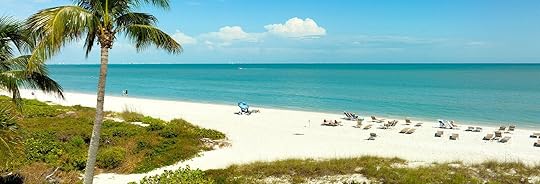
Southwest Florida is a vacationer’s dream. That comes as zero surprise to anyone who’s had the pleasure of digging their toes into the warm, white sands that stretch from Fort Myers to Sanibel Island and beyond. You could happily spend your vacation trawling for seashells and building pint-sized castles, but there’s a lot more to this region than its beaches — including some unique experiences that you might only find here.
Whether you’re into camping, murder mysteries, or high-flying helicopter rides, Southwest Florida is nothing if not memorable. Here are seven activities to help you turn up the adventure during your next unforgettable visit to the islands, beaches and neighborhoods of Fort Myers.
1. Get your glamp on.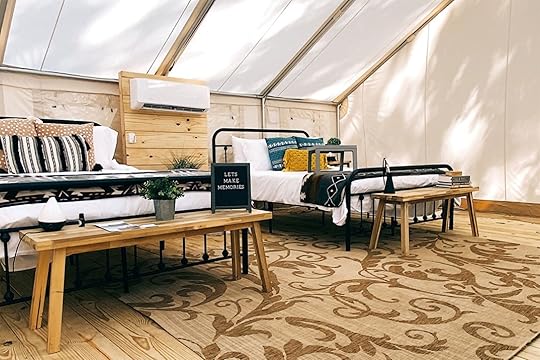
Photo: Fort Myers – Islands, Beaches and Neighborhoods
If you love the outdoors, consider a weekend glamping trip to see Fort Myers in all of its natural glory. You can camp in style at Koreshan State Park with Timberline Glamping. The extra spacious tents are decked out in sleek furnishings, with either a king bed and two bunk beds or matching queen beds. Each safari-style abode also comes with a fridge, coffeemaker, and air conditioner for optimal comfort. When you’re not lounging in your tent, get to know the property the exciting way by going biking, paddleboarding, kayaking, or fishing.
Another perk of Timberline is that its state park setting allows you to learn more about Florida’s history. The park gets its name from Dr. Cyrus R. Teed, who relocated from Chicago and established a utopian community here in 1894, calling it Koreshan. While on site, be sure to visit the Koreshan Unity Settlement, which is on the National Register of Historic Places and features 11 immaculately maintained historic structures.
2. Visit the mother of all shell museums.
Photo: Fort Myers – Islands, Beaches and Neighborhoods
There’s exactly one museum in the entire country that’s officially recognized for its collection of roughly half a million shells and myriad living mollusks. It’s called the Bailey-Matthews National Shell Museum & Aquarium, and it’s located on Sanibel Island — the “Seashell Capital of the World.”
Among the museum’s permanent and rotating exhibits are special exhibitions that’ll really open your eyes to the wide world of shells. Themes range from how seashells have been used in fashion to spotlights on specific shell families, starting with glittery abalone. You’ll also learn a lot about mollusks over at the aquarium displays and two touch pools, which collectively hold more than 60 different species. Fun fact: The mollusk classification not only includes shelled sea creatures like clams and scallops but also some larger marine animals.
3. Cruise to Cabbage Key.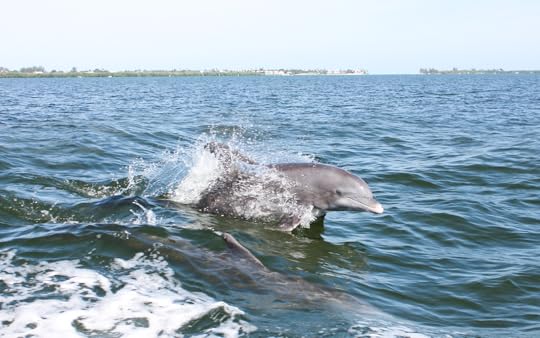
Photo: Fort Myers – Islands, Beaches and Neighborhoods
Cabbage Key, a tiny island off Pine Island with 100 scenic acres, is one of Southwest Florida’s best-kept secrets. Book a day trip with Captiva Cruises to get there, then spend the afternoon strolling the island’s winding nature trails. The four- to five-hour cruise includes a stop for lunch at the Cabbage Key Inn restaurant, which sits atop a Calusa Indian shell mound. Expect far-and-wide views from the outdoor seating area. The restaurant has been serving boaters for 60 years — commemorate your visit by adding a signed dollar bill to the hundreds that hang from the restaurant’s walls and ceilings.
Then again, you might not be ready to leave after lunch. No worries — you can always book one of the inn’s six newly remodeled guestrooms or reserve one of the cottages spread across the property.
4. Take a helicopter tour.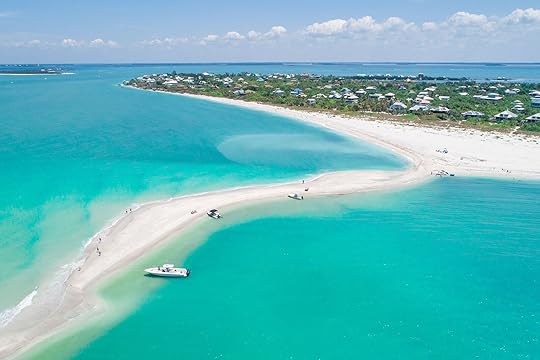
Photo: Fort Myers – Islands, Beaches and Neighborhoods
Want to see Southwest Florida like the seagulls do? Check out a heli-tour from Str8 Up Aviation. Flights come in three different durations: 30 or 45 minutes for a shorter tour or one hour for the full experience. All include aerial scenes of the region’s mangroves and beaches. If you’re lucky, you might even spot some frolicking marine life like manatees and dolphins. It’s a splurge, sure, but just imagine the memories you’ll make during a special occasion like a birthday or anniversary.
For the ultimate workout, the company can also arrange heli-yoga for you and four friends. During the 2.5-hour experience, you’ll be transported to a beautiful, remote location for a blissful private session with a yoga instructor.
5. Snuggle up to a goat.
Photo: Fort Myers – Islands, Beaches and Neighborhoods
Speaking of yoga, don’t skip goat yoga at Dim Jandy Ranch in Fort Myers. The family-owned farm hosts 1.5-hour stretching sessions on Saturdays and Sundays, so you can quite literally turn your downward-facing dog into a downward-facing goat. After the class, you’ll have plenty of time to feed your new friends and snap some photos.
If you’re planning a weekday visit, sign up for goat snuggling instead. The 30-minute sessions are offered seven days a week, except for major holidays, and the experience is open to anyone aged four and up. (You have to be at least 12 for goat yoga.) Once you’re cuddled out, feel free to roam the farm, visit the chickens, and feed the donkeys.
6. Ride a murder mystery train.
Photo: Fort Myers – Islands, Beaches and Neighborhoods
For a killer activity in Southwest Florida, beeline it to the Murder Mystery Dinner Train. Not only will you score a nice meal, but between the five courses you’ll also witness a whodunit performance play out in the train’s aisles. Armed with a playbill and clue sheet, you’ll be tasked with figuring out who, in fact, did it (and hopefully walk away with a prize).
The shows take place Wednesday through Sunday, excluding holidays, and the train leaves from Colonial Station in Fort Myers. Best of all, the program rotates its themed shows every few months, so you can take part again the next time you’re in town with zero spoilers.
7. Spend the day in an adventure-filled lagoon.The newly opened Brightwater Lagoon in North Fort Myers promises a day (or more) of fun in the sun. Be among the first to snag a day pass, which includes unlimited access to water-based activities like slides, a floating obstacle course, kayaks, and paddleboards. You can also rent a poolside cabana or tiki hut on the sandy shores of the human-made lagoon and take advantage of the swim-up bar, The Sandbar.
For a unique VIP experience, upgrade your day pass to include access to Cabana Cove, which has its own private bar and swim area. Inside Cabana Cove, you can also rent an “aquabana” — a floating cabana for you and your seven closest friends — where you can enjoy frozen cocktails on the water. When the sun goes down, there are outdoor movies and live performances scheduled throughout the week.
Venturing beyond Southwest Florida’s beaches is no easy feat. But if you do, you’ll be rewarded with a whole slew of activities that find unique ways to capitalize on the area’s beautifully warm weather. If you’ve been looking for a sunny destination where you can also have some out-of-the-box fun, it’s time to check out Fort Myers’ islands, beaches and neighborhoods. 
January 1, 2025
20 Places That Changed Us: The Most Transformative Trips the Matador Team Has Taken
 20 Places That Changed Us:
20 Places That Changed Us:The Most Transformative Trips the Matador Team Has Taken#wedge-0 { background-image: url('https://cdn1.matadornetwork.com/blogs...') }@media(min-width:560px){ #wedge-0 { background-image: url('https://cdn1.matadornetwork.com/blogs...') } }@media(min-width:1200px){ #wedge-0 { background-image: url('https://cdn1.matadornetwork.com/blogs...') } }
There are many different ways that travel can be transformative. Travel can give insight into different perspectives and new ways of looking at the world, expose people to the finest food and experiences, and can help communities and the environment in places that need it most. The Matador Network team knows this as well as anyone. Often, we landed in travel media after having our own transformative travel experiences — and then continued to seek out travel as a force for good as a career. Our line of work publishing travel stories and guides involves hopping on whatever transportation needed whenever we can so we can see destinations first-hand.
Some trips naturally stand out as more life changing than others. The reasons why are highly specific to each person, but none would be possible without an open mind and a willingness to get out of our comfort zone.
Matador’s writers and editors have collectively traveled to every continent and countless towns, cities, and countries. These are 20 of the places that we’ve gone that have changed us for the better.
Kanha Shanti Vanam, India

Photo: Heartfulness Media Team
There are few travel clichés as cringe-inducing as saying you were changed by a meditation retreat in India. And yet here I am. In 2023, I was invited to Kanha Shanti Vanam, a purpose-built town designed by the leaders of Heartfulness, a non-religious spiritual organization led by Shri Kamlesh D. Patel (Daaji). I’ve never been much for meditation or spiritual thinking. What I saw, experienced, and learned completely changed my approach to just about every aspect of my life.
It’s hard for me to describe it all without an endless word count, though I tried my best for a feature story published on Matador.
Heartfulness is an approachable take on meditation. All that’s needed is an open mind and some basic guidance to get started. My guides Hari and Darshvinder spent long days that stretched into late nights speaking with me over tea about life, work, and how the Heartfulness organization created an entire town complete with multiple restaurants, a massive meditation hall, a hotel, plant tissue research labs, farms, schools, and homes for permanent residents. Most impressive to me was how they used modern and ancient agriculture practices to turn barren land into a lush forest.
To my surprise, I still meditate the Heartfulness way whenever I can. I now apply the land management and reforestation techniques I learned in India to my own small backyard in Denver. The techniques have worked wonders during dry summers, helping me create a thriving food source without irrigation using minimal precious water. My meditation often starts with thinking about the abundance of plant life I saw at Kahna and the relationships I made. I can’t imagine a more transformative escape from the hustle of modern life. — Nickolaus Hines, managing editor
Phnom Penh, Cambodia
Visit
Phnom Penh, Cambodia
Read more
Ubud, Bali, Indonesia
Visit
Ubud, Bali, Indonesia
Read more
Kumado Kodo, Japan
Visit
Kumado Kodo, Japan
Read more
Hanoi, Vietnam
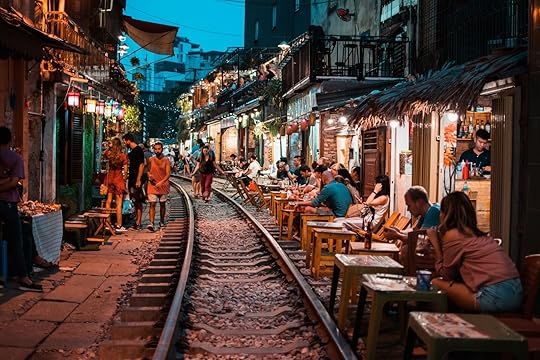
Photo: Avinash Gatreddi/Shutterstock
Hanoi is a place that rewrites your expectations the moment you arrive. Known to Americans, especially boomers like my parents, as one of the most charged places during the Vietnam War, it’s now a city that radiates beauty, warmth, and non-stop energy. Hanoi is lush with tree-lined avenues, serene lakes, and intricate architecture that feels both timeless and strikingly vibrant. It’s not untouched by the “War of American Aggression,” as they call it, and sites like the “Hanoi Hilton,” which held American prisoners of war, don’t sugarcoat the realities the country faced. But just steps from those sites are fantastic bakeries and markets, restaurants serving some of the best vegetarian food I’ve ever had, and the fascinating Vietnam Women’s Museum – not to mention cafes selling all manner of fantastic Vietnamese coffee. I find most cities kind of boring, but I could walk around looking at the sights of Hanoi all day.
For anyone craving adventure, Hanoi is a gateway to some of the world’s most breathtaking experiences. A day trip from the city might take you to Phong Nha, home to the planet’s largest cave system (tours offered between January and August; other cave tours are year-round), or you can take an overnight sleeper train to Sapa, where terraced highland trails and homestays await trekkers.
I only spent about three weeks in Vietnam and I don’t feel like I even scratched the surface. While Ho Chi Minh is perhaps more popular with tourists, I preferred the history, culture, and pace of Hanoi versus the more lively, modern, and late-night offerings of the slightly more cosmopolitan Ho Chi Minh. I’d never say no to a chance to go back. — Suzie Dundas, commissioning editor
Tokyo and Kyoto
Visit
Tokyo and Kyoto
Read more
Kyrgyzstan
Visit
Kyrgyzstan
Read more
Oaxaca
Visit
Oaxaca
Read more
Galápagos Islands

Photo: Jesse Adams
It only took one day of diving, hiking, and kayaking around the Galapagos Islands with expedition cruise line Ecoventura for my partner and I to declare this was the best trip we had ever taken. Little did we know then that every new day on the islands would top the one before, and that we would be high on life the entire time. While this trip was a work assignment, I never felt so happy and fulfilled doing my job – or anything else. Both my partner and I are animal and nature lovers, and wildlife is everywhere in the Galápagos Islands. We got to admire hours-old sea lion pups, including one with the umbilical cord still attached, frolicking in puddles, nursing, and crying for their moms’ attention. We snorkeled alongside torpedo-like penguins and spent a lot of time underwater face to face with hungry marine iguanas munching on seaweed. After a hike filled with giant tortoises sightings on the island of Isabela, we swam off a black-sand beach into the warm waters of Urbina Bay accompanied by majestic sea turtles. A trip to the Galápagos Islands is the ultimate dream for anyone who’s fascinated by the animal kingdom. I can’t wait to go back and do it all over again. — Morgane Croissant, deputy editor
Auckland, New Zealand
Visit
Auckland, New Zealand
Read more
Haiti
Visit
Haiti
Read more
Antigua, Guatamala
Visit
Antigua, Guatamala
Read more
Vienna
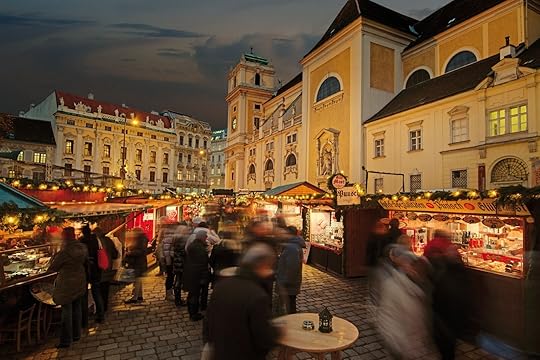
Photo: Wien Tourismus/Christian Stemper
I’m a Christmas baby. I was 15 minutes late into this world to officially hold that title, but having December 26 as a consolation birthday was a wonderful gift. This time of year reinvigorates my soul. I find joy in the smallest things, slow down, and spend time with people I adore. However, over the pandemic, when I lived alone, I found it almost impossible to muster my usual over-the-top Christmas spirit and get through my favorite time of the year. So, when restrictions were lifted, I organized a five-day trip to Vienna to explore the Christmas markets. This would also be the first trip overseas with my now-husband, who I met at the beginning of the pandemic.
Vienna is one of the most romantic cities in Europe, and in winter, it is even more so. The capital of Austria comes to life in the colder months. While many European cities hunker down and close the shutters at this time of year, Vienna is adorned with lights and decorations, markets flood public squares, coffeehouses are packed with locals coming together for einspänner (coffee with cream) and apple strudel, and people rug-up to brave to cold for concerts and ice skating. If I could sketch an ideal Christmas, it would look very much like this. Of course, this trip was missing my family, but I had my future husband’s hand to keep me warm. On one especially crisp afternoon in Art Advent market – a local market in front of the monumental Karlskirche, Church of St. Charles – we shared a cup of mulled wine as it began to snow. I knew then I’d spend the rest of my Christmases with this person, and one day, we’d return to Vienna, where our travel journey began. — Katie Gavin, lifestyle editor
Spain
Visit
Spain
Read more
Portugal
Visit
Portugal
Read more
West Coast of Scotland
Visit
West Coast of Scotland
Read more
Inishmore, Aran Islands, Ireland

Photo: Tim Wenger
At 21, I moved from France to Ireland to teach French at a rural school. While I thought I was the only young foreigner around, it turned out that there were many of us in the town: three other young French women and one young German man. We all connected instantly and spent most of our spare time together. When Lars, the German teacher, died in a car crash a few months after we met, the bond between the rest of us became even tighter through grief. At the end of the school year, the three of us who were unattached decided to have a last hurrah in the Aran Islands on the west coast of Ireland. We stayed at an empty and no-frills youth hostel and rented bikes to tour the island for five days. We criss-crossed the seemingly deserted island in all directions, lived on sandwiches we made from the provisions we got at the one small grocery store we found, and celebrated our special year and our friendship by getting lost all over Inishmore looking for puffins and standing too close to the edges of cliffs. While everything about this trip was simple, cheap, and quiet, for many years afterwards, it felt like the most special trip I had ever taken. — Morgane Croissant, deputy editor
Rwanda
Visit
Rwanda
Read more
St. Petersburg, Russia
Visit
St. Petersburg, Russia
Read more
Oslo
Visit
Oslo
Read more
CREDITSEditorial lead
Nickolaus Hines
ContributorsDebbie Gonzalez Canada, Morgane Croissant, Suzie Dundas, Katie Gavin, Nickolaus Hines, Rulo Luna, Tim Wenger, Kelsey Wilking
Places That Changed Us: Oaxaca

This is part of the “Places That Changed Us” series, a compilation of 20 trips that have had a lasting impact on the Matador Network team. To see the other 19 places, click here.
I was in in Mexico City with my now-wife Heather when pandemic closures started in March of 2021. At the time, we didn’t know it would be our last trip in a long while. We truthfully weren’t even sure if we would be able to make it back to our apartment in New York City as flight cancellations quickly racked up. We resolved to return to see another side of Mexico as soon as we could to distract ourselves from every errant cough in the airport. We finally made it happen over Thanksgiving the following year, and chose Oaxaca to embrace the spirit of a US holiday defined by indulgent food even if we weren’t in the country. The trip reignited our sense of adventure in more ways than one.

Cooking with Mimi on Thanksgiving through Airbnb Experiences. Photos: Nickolaus Hines
We started in Oaxaca City at a hotel near Mercado 20 de Noviembre. Days were quickly filled with foods from restaurants and street vendors alike. Plate after plate of mole, chapulines scooped from big baskets, and tlayudas all kept us more than stuffed between successive stops in every mezcaleria we passed. Our food highlight came, fitfully, on Thanksgiving day through an Airbnb Experience at the home of Mimi Lopez Hernandez. After a brief talk around the dinner table with 10 other guests about Mimi’s standing as a groundbreaking woman chef in Oaxaca, we were put to work to make our day’s feast using Mimi’s traditional recipes. We made fresh salsas, ground nixtamalized corn into masa on a large molcajete, and cooked tortillas on a comal over an open fire. Three different types of mole were made at once, with people moving between each to see how it was done and get tips from Mimi. It was a full day of cooking interspersed with sips of Mimi’s mezcal and gentle chiding about how my wife and I needed to have kids already. We quickly bonded with Mimi, her son Charlie (who translated when our broken Spanish failed us), and the other guests.
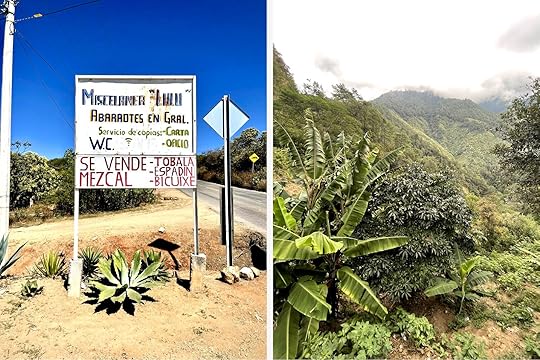 Left, a palenque near Oaxaca City. Right, Highway 175 in Oaxaca goes from desert to lush jungle in the mountains. Photos: Nickolaus Hines
Left, a palenque near Oaxaca City. Right, Highway 175 in Oaxaca goes from desert to lush jungle in the mountains. Photos: Nickolaus Hines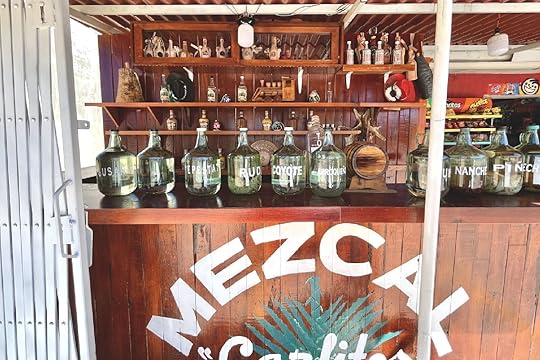 Roadside palenque showing its mezcals along Highway 175 in Oaxaca. Photo: Nickolaus Hines
Roadside palenque showing its mezcals along Highway 175 in Oaxaca. Photo: Nickolaus HinesGetting out of the state capital was just as memorable. We decided to drive to Puerto Escondido on Highway 175 in a beat up Chevy Aveo rental. The winding road to the coast is notorious thanks to dangerous one-lane passes and curves through the mountains. Without stops, it takes about six hours to go 160 miles. The risks are worth it for anyone interested in seeing the multitude of landscapes Mexico has: high desert, dense jungle, mountain pine forests filled with psychedelic mushrooms and those who hunt for them. Part of the reason we chose the trip is the long line of palenques along the road close to the city. These small mezcal distilleries make spirits with a wide range of agave types, and you won’t find them in any store. In fact, you often won’t find them anywhere else than that palenque (which often doubles as a home) unless you buy some repurposed bottles to be filled from the big glass jugs the spirits are stored in.
I can’t say the drive would be worth it for everyone. Dogs chased our car and bit our wheels when we made a wrong turn onto a private road, and we had more than one hairy experience getting a little too close to the edge for the well-worn wheels on our rental. We spent about an hour stopped by machete-wielding protestors in a valley that was a cell service dead zone. For us, it was the adventure that we wanted, complete with the finest mezcal we’ve ever had. Plus, we had a beachside Airbnb waiting in Puerto Escondido with passionfruit hanging from the vine above the doorway and an appointment to help with a baby turtle release.
 Photo: Nickolaus Hines
Photo: Nickolaus Hines Photo: Nickolaus Hines
Photo: Nickolaus HinesThe trip changed our understanding of Mexico as a whole, a country we visit often. Our limits were pushed at times, but there was never a dull moment. And we kept some friends: Mimi and Charlie have stayed in contact (she was thrilled to see our first baby announcement the following year, as well as the second announcement in 2024), as well as one of the other guests who lives a similarly travel-heavy lifestyle. 
Places That Changed Us: Oslo
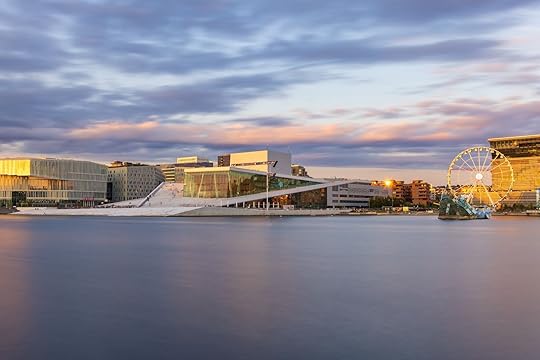
This is part of the “Places That Changed Us” series, a compilation of 20 trips that have had a lasting impact on the Matador Network team. To see the other 19 places, click here.
My now-wife and I almost couldn’t believe it when we saw a budget airline had January flights from Atlanta to Oslo for a couple hundred dollars in 2015. I was about to start my last semester of college at Auburn university in Alabama and had a dwindling savings account from working at U-Haul. She was in her gap year before starting dental school at Columbia University in New York City. It’s safe to say our budget didn’t exactly match our desire for our first transatlantic trip just the two of us. Norway’s cheap off-season flights made it a bit more feasible — at least it did when taking into consideration our blissful ignorance of how expensive day-to-day necessities are in the country.
We didn’t know much about Oslo, or even much about the cold as two coastal California kids. We did know that we could manage the price of the flight and an affordable Airbnb for a week if I skipped the start of classes to travel on cheaper days. There was even a little money left for economical winter clothes (there’s no bad weather, only bad clothes, as Norwegians kept telling us when we arrived). By the end, we both had a new appreciation for the cold, off-season travel, and the joys of not really knowing what’s to come until the plane lands.
We walked for miles each day in the snow on the hunt for cheap or free entertainment. The search led us to sculpture parks, long winter sunsets over the water, and ski rentals on a gentle slope. We stumbled on the Frognerseteren toboggan run and rented sleds for under $10. The 10-minute run goes for just over a mile and drops 740 feet. Best of all? We could test our skills along sharp turns with few barriers for free, and then take the metro back up to the start to do it all over again.
We normally travel for the food and drinks first and foremost. It was a bit different in Oslo. We ate a lot of yogurt and the unofficial national dish of frozen pizza with glasses of Vikingfjord vodka. Our splurge was to try traditionally prepared whale and reindeer — both things we knew we wouldn’t try elsewhere, or likely ever again. We tried to go bar hopping until we learned many of the bars we wanted to go to were for people 25 and older, though the karaoke bar we settled at turned out to be the perfect fit: a bold Aerosmith duet made the locals warm up to us so much we ended up chatting and singing and drinking until the bar closed.
More than a decade later, the full impact that the trip had on me is in better focus. It kickstarted my love for off-season travel and seeing things from a more local perspective. Also for creating our own fun in a new place regardless of budget. 
Places That Changed Us: Tokyo and Kyoto

This is part of the “Places That Changed Us” series, a compilation of 20 trips that have had a lasting impact on the Matador Network team. To see the other 19 places, click here.
The first thing I did after dropping my bags at our Tokyo Airbnb in Shinjuku was to head to the 7-Eleven on the corner. My wife Heather, 1-year-old daughter Margot, and I were famished after a five hour delay on our 11-hour flight from Denver, and didn’t arrive until close to midnight on Thanksgiving week in 2023. I’d heard about Japan’s famous 7-Eleven food and couldn’t think of a better first meal than some noodles, a katsu sandwich, and bottle of sake. They weren’t the best noodles we had on the trip of course, but my daughter immediately picked up how to properly noodle slurp and started her love for Japanese noodles that hasn’t wavered even now more than a year later.
A direct flight from Denver to Tokyo on United Airlines was the inspiration for the trip. Now, Japan is one of the countries I dream about most and my interest is always peaked at any mention of a chance to return. As much as I love fresh Italian pastas, rich French sauces, and streetside tacos in Mexico, Japan immediately shot to the top of my list of favorite food cultures even after a decade of writing about food and drinks.
 Left, wagyu at Yakiniku Toraji in Tokyo. Right, matcha at the park. Photos: Nickolaus Hines
Left, wagyu at Yakiniku Toraji in Tokyo. Right, matcha at the park. Photos: Nickolaus Hines The classic martini at Star Bar in Tokyo. Photo: Nickolaus Hines
The classic martini at Star Bar in Tokyo. Photo: Nickolaus Hines Left, measuring up at the wholesale fish market in Tokyo. Right, eating soba in Kyoto. Photos: Nickolaus Hines
Left, measuring up at the wholesale fish market in Tokyo. Right, eating soba in Kyoto. Photos: Nickolaus HinesParks, temples, and incredible gardening displays were all intriguing in their own right, but truthfully we treated them as ways for us to rebuild our appetites over eight days in Tokyo and Kyoto. We ate more wagyu than I thought possible at Tokyo’s Yakiniku Toraji, and devoured soba at Soba-no-Mi Yoshimura in Kyoto after passing the chef hand slicing the noodles downstairs. Skewers of chicken gizzards, impossibly fluffy doughnuts, and sugar-glazed strawberries joined our list of snacks and mini meals alongside just about every to-go food I could find at 7-Eleven. Counter-service ramen at Ramen Nagi on a cold morning at 9 AM cannot be compared. The same goes for Japanese whisky, shochu, and stand-out martinis from cocktail bars at night, vending machine hot coffee and cold beers during the day.
And that’s not even getting into all of the seafood. It took me seeing it to believe how easy it is to stumble into any smell-free seafood market or restaurant and be served higher-quality fish than all but the costliest sushi places in the US. Oysters, clams, crab, and too many types of nigiri to count at Kyoto’s Nishiki Market. The most succulent fatty salmon from casual izakayas and Tsukiji Market alike. On a sake and izakaya tour with the crew from Sake Bar Doron in Tokyo that we booked through Airbnb Experiences, our host told us there is no such thing as a bad restaurant in Japan because of how much pride the chefs have in their work. (I believe him wholeheartedly with one exception: Japanese “Mexican” food from a street cart that used sushi rice and avoided any hint of spice with a “salsa” that tasted more like pasta sauce.) And in a major surprise to me, it was all extremely affordable. We stuffed ourselves on one memorable meal after another for a fraction of the cost to eat at even a casual diner stateside.
 Left, the writer and his baby on the balcony of their Tokyo Airbnb. Right, exploring the temples in the fall in Kyoto. Photos: Nickolaus Hines
Left, the writer and his baby on the balcony of their Tokyo Airbnb. Right, exploring the temples in the fall in Kyoto. Photos: Nickolaus Hines Shibuya Crossing, one of the busiest intersections in the world. Photo: Nickolaus Hines
Shibuya Crossing, one of the busiest intersections in the world. Photo: Nickolaus HinesEven the most food-focused trip isn’t about the food alone, however. Japanese culture left just as big of an impression. From children to the elderly, I lost count of how many times passerby exclaimed “totemo kawaī!” (“so cute”) and worked through the language barrier to ask if they can interact with my daughter who was usually attached to my chest in her Baby Bjorn. Even on the notoriously silent trains, any peep from Margot was greeted by a host of people who wanted to make her smile. Traditional architecture and modern art blend into daily life in Japan, and everything seemed perfectly designed and neatly arranged to fit just right no matter how small a space. I can’t say I’ve brought the same level of order and cleanliness into my own life, but I’ve certainly been inspired enough to try.
Japan wasn’t high on our list of places we wanted to go until we spotted the non-stop flight. Now my perception of great food cities is forever altered, as is my understanding of how organized, clean, navigable, and friendly a massive metropolis can be. 
Places That Changed Us: Haiti

This is part of the “Places That Changed Us” series, a compilation of 20 trips that have had a lasting impact on the Matador Network team. To see the other 19 places, click here.
Haiti is rarely considered a must-visit Caribbean destination. For many, the country is a reminder of tragedy — a place defined by headlines about natural disasters or political unrest. On January 12, 2010, a devastating earthquake leveled the capital, Port-au-Prince, claiming over 300,000 lives and displacing millions. With a third of the population left homeless and an infrastructure already strained by corruption and limited resources, Haiti was thrust into a prolonged state of crisis.
That same year, I got married. At just 23, my husband and I were navigating through mountains of advice, but one suggestion stood out: “In your first two years, go serve. Do something that matters, together.” By the summer of 2012, we were on a plane to Haiti, joining reconstruction efforts while the country was struggling to recover.
With international aid drying up, the focus was on building small homes to move families out of sprawling tent cities. Under the blistering sun, my husband and I joined local crews to construct tiny houses, completing several. Later, we helped build a school for an orphanage, surrounded by children laughing with mouths full of fresh mangoes from nearby trees.
The children’s joy was contagious. Their bright smiles and boundless energy paired with my very rusty French made for laughter and playful moments during our breaks. Local women braided my hair after long days of construction. In some afternoons, my husband entertained the kids with his guitar, singing silly, made-up songs in a hilariously terrible falsetto that had them laughing nonstop.
But silly songs weren’t the reality they lived. The orphanage had received 30 chickens the week before we arrived as part of a program to teach the children sustainable skills and provide eggs to sell. By the time we got there, every chicken was eaten. When survival is a day-to-day struggle, concepts like saving or planning for the future become a luxury.
That trip taught me what privilege truly means. A five-year plan, learning something new, enjoying nature, even believing in tomorrow — these are all privileges. How can anyone dream of growth or gratitude when they are starving, unsheltered, and unsafe? We wanted to leave Haiti better than we found it, to use our privilege to give others a fighting chance. Yet everything we brought — sheets, toiletries, even our labor — felt painfully inadequate. The people we met didn’t deserve their fate. They wanted to live, to thrive, but they couldn’t. They tried, and the world seemed to work against them at every turn. The experience reshaped our worldview forever. Haiti left an indelible mark on my soul. Its incredible people, trapped without hope of a tomorrow, changed me in ways I’m still grappling to understand. 
Places That Changed Us: Antigua, Guatemala

This is part of the “Places That Changed Us” series, a compilation of 20 trips that have had a lasting impact on the Matador Network team. To see the other 19 places, click here.
I set a goal to learn a new language before my 35th birthday, and Duolingo just doesn’t cut it for my kinetic, ADD brain. So I opted for a hands-on approach in 2022: I spent five weeks as a solo traveler in Antigua, Guatemala, immersing myself in Spanish. Through an international program, I was paired with a local Guatemalan tutor named Fernando. Every afternoon, we met in a cozy coffee shop for four hours of one-on-one lessons.
When we first met, my Spanish repertoire consisted of “hola” and the wildly incorrect “baño, por favor.” Fernando spoke only a little English, but together we bridged the gap with hand gestures, facial expressions, and impromptu charades. He patiently guided me through verb tenses and vocabulary, occasionally giving me a playful bop on the head with a rolled-up newspaper whenever I pronounced Spanish words with a French accent.
I used to joke that I must be his oldest student — someone who hadn’t studied the language in high school or college and was starting from scratch. But Fernando always countered, “No, no, adults make the best students. They actually want to learn; they’re not just checking a box.”
In the mornings and evenings, I worked remotely, and on weekends, I explored Guatemala. I hiked El Fuego, marveled at the ancient ruins of Tikal, and practiced my Spanish with locals along the way. Speaking the language added depth to my experiences, allowing me to connect with the culture in ways I never could have otherwise.
Guatemala became part of my soul, and Fernando became more than just a tutor, he became a friend. Two years later, we still have weekly Zoom sessions to continue my lessons. I even send him birthday and Christmas gifts to show my gratitude for the patience and humor he brought to my learning journey. 
Matador Network's Blog
- Matador Network's profile
- 6 followers



